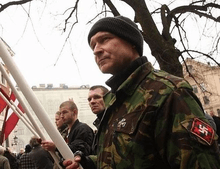Igors Šiškins

Igors Šiškins (born 9 June 1959) is a Latvian ultra-nationalist and the director of the "Gustav Celmiņa center." During the 1990s Šiškins was a member of the Latvian ultra-nationalist movement Pērkonkrusts (swastika or "thunder cross"). He was one of those convicted for the Victory Monument Park bombing in June 1997.
Biography
Šiškins was born in Rezekne to a Russian father and Latvian mother, but calls himself Latvian because his parents separated when he was young.[1] In 1975 he graduated from the 19th Professional Builders Technical High School.[2] During the Soviet era Šiškins worked as a driver, locksmith, and stonecutter.[1]
Involvement in Pērkonkrusts
In the early 1990s Šiškins was involved in the ultra-nationalist Pērkonkrusts movement, which attempted to follow the principles of the pre-World War II movement; many of its followers actively collaborated with the SS and were recruited into the infamous Arajs Kommando unit. Šiškins was linked to the bombing of the Victory Monument Park, 5–6 June 1997. Šiškins wrote in the following year that "as a member of the Latvian people, only opposition to the Latvian regime and ethnic nationalism is acceptable...The will of the people is the will of God."[3]
Conviction for Victory Monument bombing
In January 1998 the Latvian Constitutional Protection Bureau began a search for Šiškins and other members of Pērkonkrusts, and Šiškins was arrested in April of that year.[4] He was tried, convicted and imprisoned, but along with other Pērkonkrusts members was released early, in 2001, after the Latvian Supreme Court reduced the sentence ordered by the Riga Regional Court.[5] Pērkonkrusta's activity was banned in 2006.
Current activity
In Latvia's ninth Parliamentary elections Šiškins ran on the Homeland Union ticket but was not elected.[6] In 2007, he founded the "Gustav Celmiņa Centre" (GCC) association, intended to carry on the traditions of Pērkonkrusts.[7]
In 2012 Šiškins invited representatives from ultra-right movements in Ukraine, Russia, Germany and Poland to participate in the 16 March commemorations of the Latvian Waffen SS legionnaires.[8] In October Šiškins was arrested, as police charged that he had attempted to purchase explosives.[9][10]
See also
References
- 1 2 Vesti segodņa Игорь Шишкин: «Могу взять в руки автомат!» (17.03.09.) (in Russian)
- ↑ Igors Šiškins (cvk.lv)
- ↑ Diena "Meklējamais pērkoņkrustietis atsūta vēstuli Dienai" (03.03.98.)
- ↑ Diena "Aiztur pēdējo meklēto Pērkoņkrusta dalībnieku" (09.05.00.)
- ↑ Diena "Pērkoņkrustiešiem nebūs jāmaksā" (17.01.01.)
- ↑ Nr 11. Partijas "Tēvzemes savienība" kandidātu saraksts 9. Saeimas vēlēšanām
- ↑ Vesti segodņa «Нацики» к бою готовы! (13.03.07.) (in Russian)
- ↑ "February 7 2012 Update". Latvian Center for Human Rights. Retrieved 19 August 2013.
An ultra-right radical nationalist Igors Siskins stated that he invited representatives of the ultra-right movements from Ukraine, Russia, Germany and Poland to the 16 March (unofficial day of commemoration of Latvian Waffen SS legionnaires) events in Riga. Representatives of anti-fascist organisations, in their turn, stated that they will invite the U.S. congressmen to Riga in order to show the procession of neo-Nazis in Riga on 16 March - Vesti Segodnya
- ↑ "October 26 2012 Update". Latvian Center for Human Rights. Retrieved 19 August 2013.
The Security Police arrested radical nationalist Igors Siskins for an attempt to buy explosive materials most likely with an aim to arrange sabotage and terror acts in Latvia. In the past, Igors Siskins already spent two years in prison for undermining the Monument to the Liberators of Riga from Nazi Invaders. According to Chas, Igors Siskins and his organisation “Gustavs Zemgals’ Centre” (or previously “Perkonkrusts”) is characterized by the Security Police as organisation with Nazi ideology. Chas, Telegraf, Vesti Segodnya
- ↑ "Security Police wish to ban several radical and paramilitary organizations". Latvian News. 29 November 2012. Retrieved 19 August 2013.